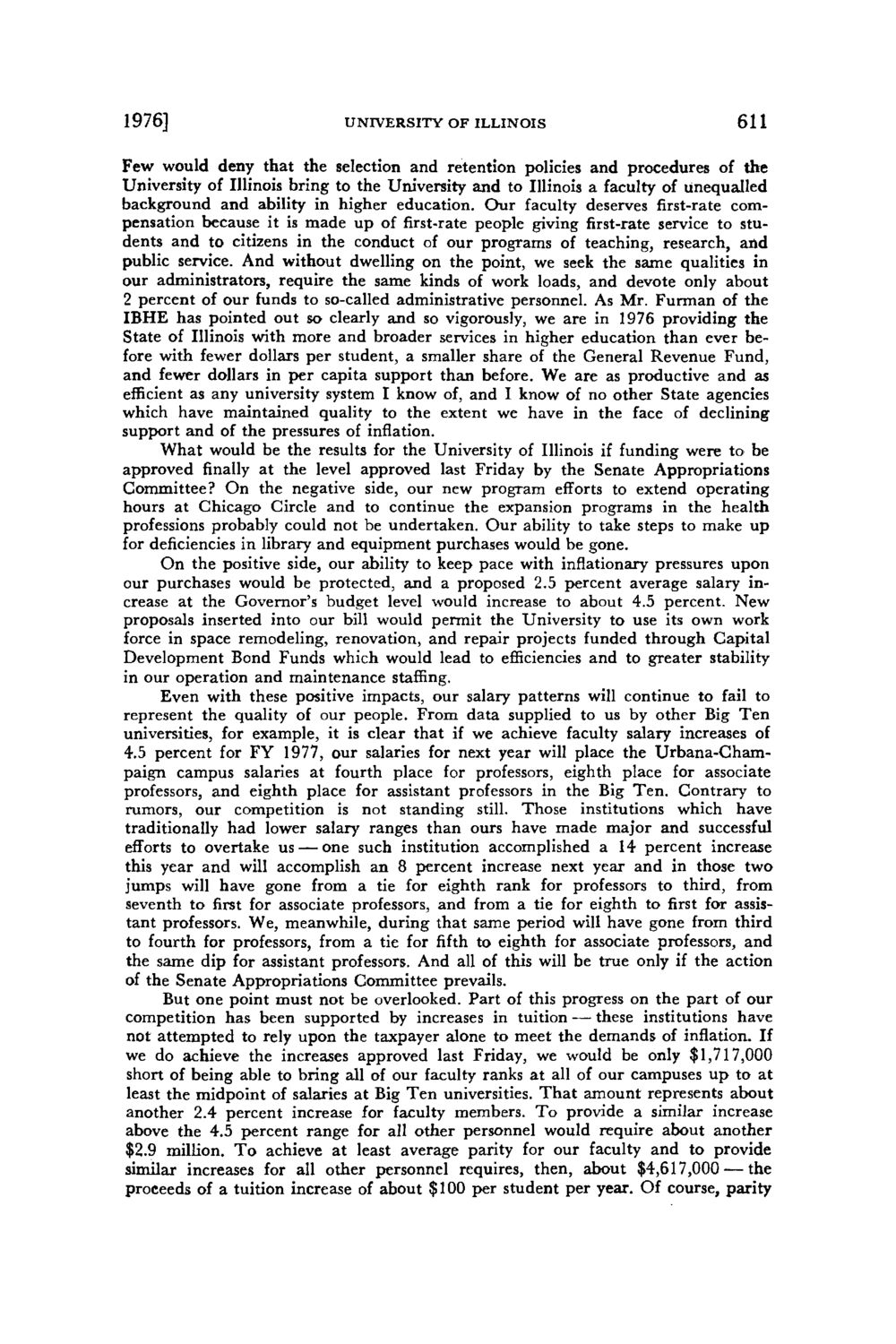| |
| |
Caption: Board of Trustees Minutes - 1976
This is a reduced-resolution page image for fast online browsing.

EXTRACTED TEXT FROM PAGE:
1976] UNIVERSITY OF ILLINOIS 611 Few would deny that the selection and retention policies and procedures of the University of Illinois bring to the University and to Illinois a faculty of unequalled background and ability in higher education. Our faculty deserves first-rate compensation because it is made up of first-rate people giving first-rate service to students and to citizens in the conduct of our programs of teaching, research, and public service. And without dwelling on the point, we seek the same qualities in our administrators, require the same kinds of work loads, and devote only about 2 percent of our funds to so-called administrative personnel. As Mr. Furman of the IBHE has pointed out so clearly and so vigorously, we are in 1976 providing the State of Illinois with more and broader services in higher education than ever before with fewer dollars per student, a smaller share of the General Revenue Fund, and fewer dollars in per capita support than before. We are as productive and as efficient as any university system I know of, and I know of no other State agencies which have maintained quality to the extent we have in the face of declining support and of the pressures of inflation. What would be the results for the University of Illinois if funding were to be approved finally at the level approved last Friday by the Senate Appropriations Committee? On the negative side, our new program efforts to extend operating hours at Chicago Circle and to continue the expansion programs in the health professions probably could not be undertaken. Our ability to take steps to make up for deficiencies in library and equipment purchases would be gone. On the positive side, our ability to keep pace with inflationary pressures upon our purchases would be protected, and a proposed 2.5 percent average salary increase at the Governor's budget level would increase to about 4.5 percent. New proposals inserted into our bill would permit the University to use its own work force in space remodeling, renovation, and repair projects funded through Capital Development Bond Funds which would lead to efficiencies and to greater stability in our operation and maintenance staffing. Even with these positive impacts, our salary patterns will continue to fail to represent the quality of our people. From data supplied to us by other Big Ten universities, for example, it is clear that if we achieve faculty salary increases of 4.5 percent for FY 1977, our salaries for next year will place the Urbana-Champaign campus salaries at fourth place for professors, eighth place for associate professors, and eighth place for assistant professors in the Big Ten. Contrary to rumors, our competition is not standing still. Those institutions which have traditionally had lower salary ranges than ours have made major and successful efforts to overtake us — one such institution accomplished a 14 percent increase this year and will accomplish an 8 percent increase next year and in those two jumps will have gone from a tie for eighth rank for professors to third, from seventh to first for associate professors, and from a tie for eighth to first for assistant professors. We, meanwhile, during that same period will have gone from third to fourth for professors, from a tie for fifth to eighth for associate professors, and the same dip for assistant professors. And all of this will be true only if the action of the Senate Appropriations Committee prevails. But one point must not be overlooked. Part of this progress on the part of our competition has been supported by increases in tuition — these institutions have not attempted to rely upon the taxpayer alone to meet the demands of inflation. If we do achieve the increases approved last Friday, we would be only $1,717,000 short of being able to bring all of our faculty ranks at all of our campuses up to at least the midpoint of salaries at Big Ten universities. T h a t amount represents about another 2.4 percent increase for faculty members. T o provide a similar increase above the 4.5 percent range for all other personnel would require about another $2.9 million. T o achieve at least average parity for our faculty and to provide similar increases for all other personnel requires, then, about $4,617,000 — the proceeds of a tuition increase of about $100 per student per year. Of course, parity
| |